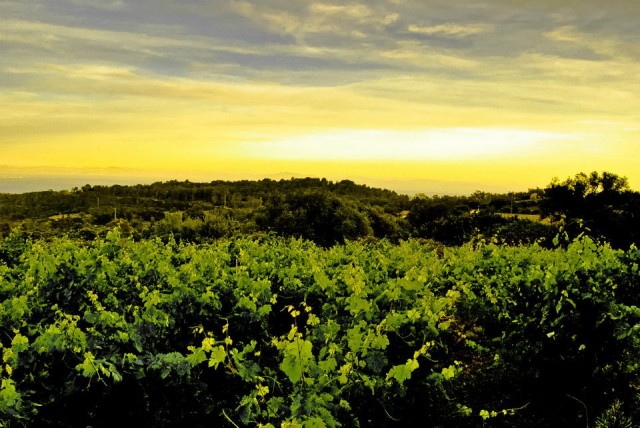
Over the last few years, a quiet revolution has been taking place within the wine industry. Winemakers are creating biodynamic and organic wines; wineries are opting for alternative packaging and renewable energy sources; and oenophiles are supporting wines that don’t contain chemicals left over from the use of pesticides and herbicides with their purchasing power. Read on to find how wineries around the world are “going green.”
Clos de la Coulée de Serrant, Loire Valley, France
The dry white wine of Clos de la Coulée de Serrant is praised by critics the world over for its taste and quality, but the way in which the wine is made is just as praiseworthy. Cistercian monks planted the vineyard in 1130, and biodynamic practices have been in place since the early 1980’s.
Synthetic chemical products are not only banned from the vineyard, but from the entire estate. A herd of 10 estate-owned cows (including Nantasies, a rare breed) provide the compost for biodynamic preparations. Flocks of Ouessent sheep graze on the cover crop (weeds) in the winter months in place of herbicides. Grapes are harvested in a series of three to five sessions to guarantee full maturity of the grape, without the use of clones. With these eco-friendly practices (and many more) in place, Clos de la Coulée de Serrant, and its winemaker, Nicolas Joly, have become pioneers in the biodynamic wine movement. Joly has penned several books on the matter, and is regarded as a specialist in the field.
Stellar Organic Winery, Western Cape, South Africa
What started as a niche product, has resulted in the world’s largest production of no-sulphur-added wines. Stellar Organic Winery, South Africa’s largest producer of fair-trade, organic wines is another trailblazer in the industry:
It was the first organic winemaking operation in the world to gain FLO Fairtrade certification and the first cellar in Africa to produce commercially viable no-sulphur-added wines. (StellarOrganics.com)
They also practice natural pesticide methods including the use of Indian Runner ducks to control the snail population, water usage auditing, recycling of waste products (such as using grape skins from the press as compost) and reducing their carbon footprint by using lightweight glass bottles and PET containers in the UK. (From Stellar Eco Report, updated 2/11)
Domaine Spiropoulos, Peloponnese, Greece
The Spiropoulos family has been involved in winemaking since 1860 and has been experimenting with organic viticulture since 1993. The winery is located in the center of the Peloponnese on a plateau, covering a total of 50 hectares where a variety of different grapes are cultivated. They’ve been committed to making a difference in the wine world and converted the old winery into a research facility for vineyards and wine, as well as maintain memberships in several organizations committed to the improvement and shaping of the Greek wine industry.
In the 1980’s and 90’s, when cutting-edge equipment wasn’t available in Greece, the family imported the necessary machinery from other countries. They also maintain their own recycling operation, as one isn’t available in the neighboring city, and collect and reuse rainwater. They are certified organic by several different global organizations, and are currently awaiting approval from the USDA.
Gustavo Caligiore, Mendoza, Argentina
Another family owned and run operation, Gustavo Caligiore wines of Argentina sold its grapes to local vintners until Gustavo Caligiore III took over the winery in 2001. Now, they produce 80,000 bottles a year of premium organic wine where 20 percent is sold domestically, and the remaining 80 percent internationally. (winesur.com)
In a March 2010 feature by Sommelier Journal, Caligiore explained how his winery uses organic practices:
By using no pesticides or herbicides, we help create an environment where there is no possibility of contamination. Our vines grow in a balanced ecosystem, together with many other species of plants and insects, where pests and illnesses are auto-controlled (not eliminated) and kept below the threshold of economic damage naturally, without using any chemicals.
Caligiore also believes in maintaining a balanced ecosystem by keeping his vines near many species of insects and plants, and keeping the soil partially covered year-round, allowing for microorganisms to decompose organic matter and mobilize nutrients.
As consumers begin to value their purchasing power more, perhaps we’ll continue to see a rise in palatable organic and biodynamic wines around the world.
Weigh In: Have you ever tried organic or biodynamic wine?
 About Christine Medina
About Christine Medina
Christine Medina is a freelance writer, aspiring photographer and wanderlust-stricken expat currently living in Andalusia, Spain. Upon graduating from The University of Washington with a BA in Communications and a BA in Social Science, she set off to Spain to immerse herself in a new culture and learn the Spanish language. She writes about expat life and all things Spain on her blog, http://www.christineinspain.



